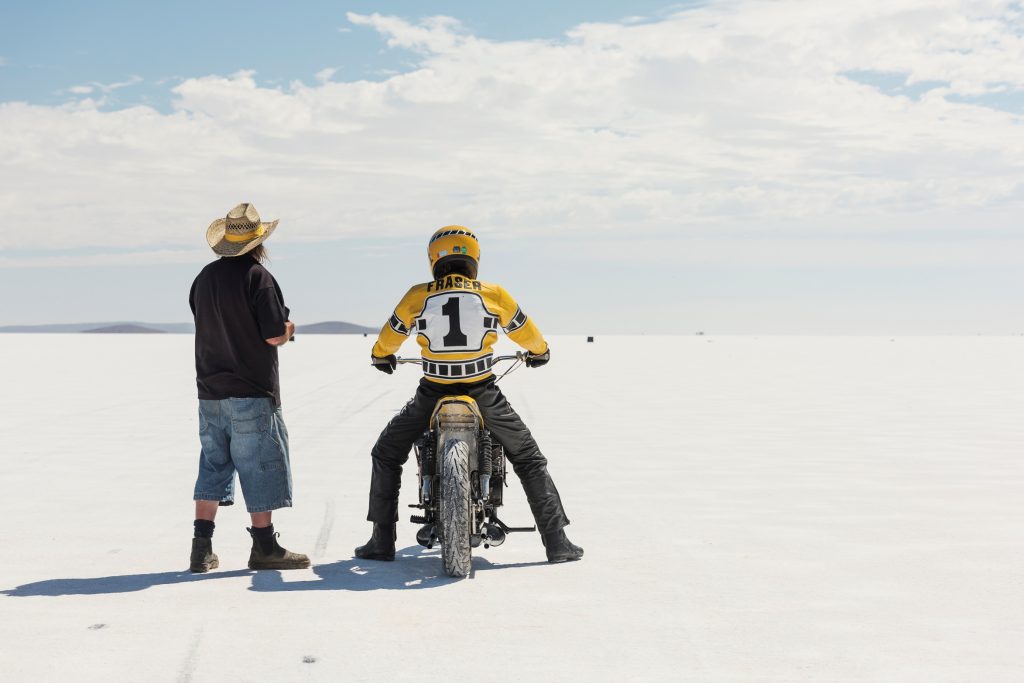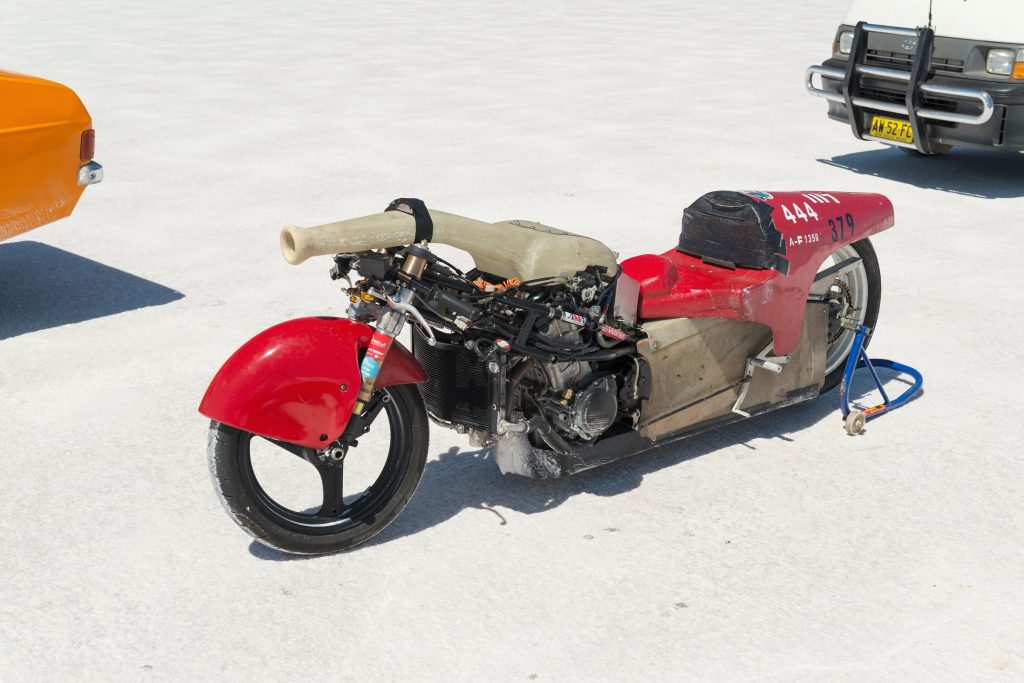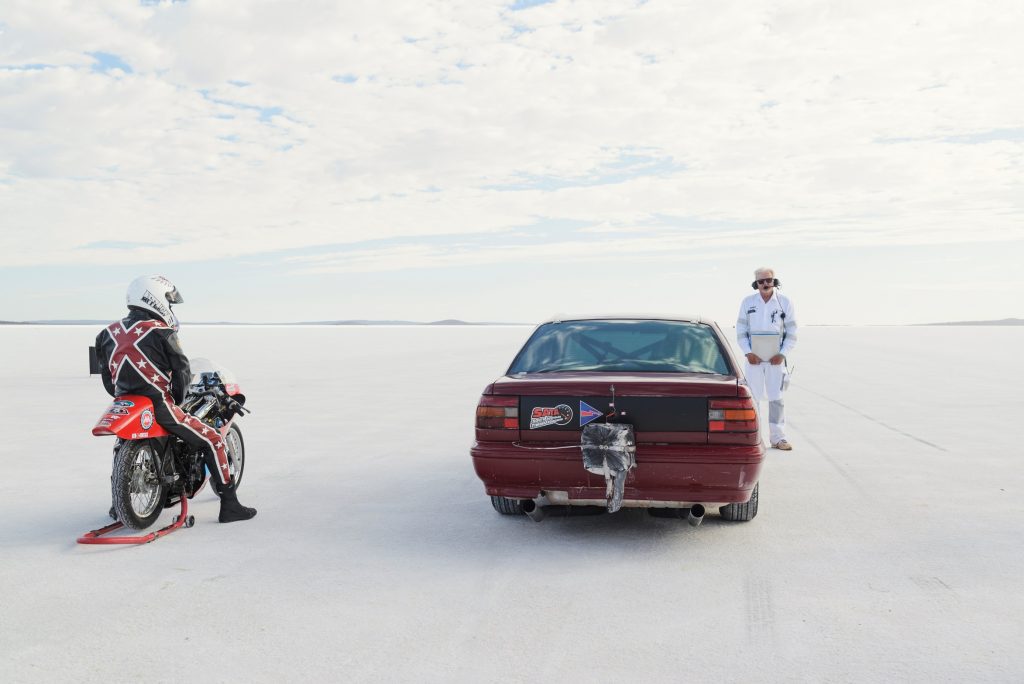The days start early, well before dawn, as racers and crew emerge from their bush camps beside the lake to make their way to the pits situated midway along Track 1. It’s never cool out here but at least it’s not hot, and the flies are still asleep. As the sun rises over the far range, engines kick into life and racers make their way to the starting area. Welcome to Speed Week.
Lake Gairdner is spectacular at any time, but never more so than at dawn, especially if you’re out there on the lake itself. Surrounded by barren outback sheep stations, the 160km-long dry salt lake is a national park and significant indigenous site, and access is strictly controlled. Yet here we are, a bunch of unwashed petrol heads about to race our open-piped bikes and cars on its pristine rock-hard surface as fast as we possibly can.

Racers chasing maximum horsepower favour the dense morning air, which accounts for all the early activity. The truly fast guys are less fussed. Making horsepower isn’t the hard part, they say; punching a hole in the air is, so they don’t mind it hot and thin. What’s common to all riders and drivers is that they will stay hard on the gas, literally flat out, for miles and miles, and there are no decibel limits or sound barriers. The glorious noise rolls on long after they are out of site and then, when it finally starts to fade, it echoes back from the other side of the lake. And still they stay on it.
The hot rodders first ventured to Lake Gairdner to live the Bonneville dream in 1990, forming Dry Lakes Racers Australia to (manage) their new sport along the way. Nine cars competed, with one of the DLRA founders Rod Hadfield fastest at 147mph in a 1932 Ford. Three bikes made a fleeting appearance in 1994, but it wasn’t until 1998 that bikes raced again. Numbers then slowly grew from seven that year to 21 in 2005. And then The World’s Fastest Indian came out. This year 90 motorcycles lined up for the starter’s flag alongside 30 cars, split roughly between purpose-built race bikes like Burt Munro’s and road or track bikes having a big day out.
Salt racing is a funny old sport. As with drag racing, everything is in miles per hour and then you have to get there. Lake Gairdner is deep in the South Australian outback at the end of a long corrugated dirt road. The closest town is Port Augusta, 200km away, and the closest capital Adelaide some 500km to the south. It’s a 1300km haul from Melbourne, 1800km from Sydney and 2500km from Perth. And when you do arrive, there’s … well, not much. You bring everything in, you take everything out.

It also happens just once per year in late summer when the mercury is soaring and there are no rain dates. Unbelievably, the event has been washed out six times, twice in consecutive years and four times in the past decade. Brian Fullard came up from Melbourne in 2010 for a taste and immediately set about building a salt bike from a TT500 Yamaha, only to have the event cancelled in 2011 and 2012. It was a frustrating time but he eventually debuted in 2013 and set a class record of 126mph in 2014. This year he removed the fairing late in the week chasing the non-streamlined record of 111mph and smashed it by 10mph. It’s a long-term sport and good things come to those who are patient.
Racing is conducted on two tracks, with the faster teams having priority on the longer Track 1. Both tracks are electronically timed and skimmed with large metal blades for a smooth surface, but traction is well short of the tar. Greg Watters from Wunghnu in Victoria has been competing since 2004 and is Australia’s most successful motorcycle land speed racer, a multiple world record holder who has run as fast as 256mph (two-way average) at Bonneville on a turbocharged Hayabusa. He reckons people who are comfortable on the dirt tend to go well on the salt as the bikes can move around a bit. If you’re from a purely tar background, he says, it can take some learning.
As with Burt, 200mph is the holy grail, with seven riders hitting that mark for the first time at Speed Week 2016. One was Kevin Magee who was riding a ’Busa as part of Ben Felten’s Team BlindSpeed. Ben from Sydney is a keen motorcyclist who lost his sight to disease at age 23 but has not let that stop him riding, which he does on the track with the assistance of chase riders with UHF radios following close behind. He is already Australia’s fastest visually impaired rider and is aiming for the Guinness world record for the fastest speed for a motorcycle ridden blindfolded, which currently stands at 165mph. Magoo is his test rider and he and Ben later went for a 130mph shakedown run on the salt after racing finished for the week, ready for a serious crack in 2017.

Others included Kim Krebs from Yackandandah, Victoria, and Queenslander Bradley Bowden. Kim got into speed racing after meeting Greg Watters at the WSC at Phillip Island and she too is a genuine world record holder with a two-way average of 229mph set on a turbocharged GSX-R750 at Bonneville in 2012. That bike and Greg’s world-record ’Busa were torched in the catastrophic Victorian bush fires of February 2014, along with all his tools, parts and moulds, but what doesn’t kill salt racers only makes them stronger. Riding a replica of the Bonneville GSX-R, Kim ran her first local 200mph pass (actually 214mph) to cement her place as Australia’s fastest female rider, ahead of Moe real estate agent Rebecca Robinson who ran 169mph on her VMAX.
Bradley Bowden was another one to reach the magic double century, but his path to 200mph could not have been more different. Ticking an item off his bucket list, the longtime vintage motocrosser and first-time salt racer brought along a new H2 Kawasaki fitted with a Brocks Performance hop-up kit from the US. After travelling down with his family from the Sunshine Coast, he breezed through his 125, 150 and 175mph licensing passes and ran just over 200mph on his fourth and final pass. Job done! Both Kim and Bradley also set new Australian records for their respective classes.
The fastest rider for the week was Grant Schlien, who ran 229mph on a Hayabusa, the weapon of choice for those who want to go very quick. Neill Finlay wasn’t far behind at 222mph and then came Rebecca’s brother Ken Robinson at 215mph, with Grant and Ken setting new class records. Best of the rest was Greg Watters, who ran 213mph on Kim’s 750 sans fairing and also rode Dave McLachlan’s low-slung Bones Speed special to 206mph. Craig Delforce set a new class record at 201mph on his BMW S1000RR and Jonathon Greensdale was the best of the Kawasakis, also with 201mph.
To put those speeds into context, some of the cars went quite a bit quicker, notably Mark Love running 242mph in a Pontiac Firebird, Shane Benson 257mph in John Dent’s belly tank and Lionel West 271mph in a VR Holden. Say what you like about tin-tops, but the sound and sight of an old Commodore roaring past at 437km/h is something to behold.
Most of the action happens under 200mph, however. There are more classes than competitors and records to be had at all speeds. Often a racer will set a record on regular petrol for the Gas class, then switch to racing fuel for a shot at the corresponding Fuel class. Same goes for running faired and unfaired. Thus, some 73 new records were set this year, 50 of them on motorcycles and many of them new. This was especially the case among the tiddlers, not the usual preserve of speed racers. No one had ever before raced a lowered and stretched, normally aspirated postie bike, for example, but Perth’s Kasey Plecas did and he is now the proud owner of an Australian land speed record at just over 62mph. His uncle David Plecas already holds the blown postie record at 111mph so nothing like keeping it within the family. Ditto former Top Fuel bike racer Warren Afflick, who set a new record of 113mph in the supercharged 100cc class, four mph faster than his son Jean-Paul achieved on the same bike last year and five mph faster than any other 100cc bike has ever run anywhere in the world. Not to be left out, Jean-Paul ran 114mph to claim the record for Australia’s fastest normally aspirated 350, one that is sure to be challenged in 2017.
The youngest racer was 13-year-old Nat Gaghan, who found a record at 119mph on a 1985 GS650 Suzuki, and behind him on the start line was 70-year-old Alan Blackwood running 170mph on his 1999 Triumph Sprint. While well off the 1000cc class record, it does make him Australia’s Fastest Triumph ahead of Ross Osborne who ran an incredible 156mph on his distributor-backed 2008 Thruxton. The team’s three-year objective has been to run faster than Sir Alan Cathcart’s best run of 153mph when setting the official Thruxton world record at Bonneville in 2009, with the boys switching to a shorter-stroke engine late in the week to find the magic number.
Others to take home bragging rights were Russell Lowe on Australia’s Fastest MV Agusta (169mph) and Peter Dean who ran 167mph on his mostly stock 1098 to claim Australia’s Fastest Ducati. But few could match Pro Stock drag racer Corey Buttigieg who ran 175mph on a Harley Road Glide complete with stock fairing and panniers! You can read that again slowly if you like. As with Osborne’s Triumph, this was a distributor-backed effort and eclipsed the existing world record for a two-litre bagger of 171mph, albeit set in one direction only but crikey, 280km/h on a Harley-Davidson dresser? The guy has balls of steel! Fastest Sportster was James Bragg at 160mph while Darwin’s Mick Hite ran 154mph on his 1200 Buell, both to new class records.
Another unlikely candidate was Broken Hill’s Cecil Fraser riding his father Chris’s exquisite replica of Kenny Roberts’ legendary TZ750 flat-tracker, a bike so fast and brutal that Roberts himself demanded it be banned from dirt-track competition. Mindful of seizing an irreplaceable engine, 22-year-old Cec built up revs gradually over the week, eventually setting a new class record of 135mph.
While competitors mostly think about it as racing against themselves, a fantastic tussle developed in the modified 750 class between longtime record holder Bob Prior from Sydney and his good friend Stephen Finn of Port Pirie in South Australia. Bob was a well-known drag racer back in the day and one of the first in Australia to make real horsepower out of a GT750 Suzuki, running as fast as 11.3 seconds at 116mph. He later set a local land speed record of 149mph, inspiring Stephen to build a 120hp reed-valve GT750 that he has been developing since 2009. Knowing Stephen was snapping at his heels, Bob returned in 2016 on a 2003 GSX-R750 and made the early running registering a 150mph pass with Stephen a hair behind. Next morning, Bob was doing his half-day’s volunteer labour (as all competitors are required to do), working on the DLRA merchandise stand with Rod Hadfield, when news came over the UHF radio that Stephen had run 153 and change. That’s my record, Bob cried out! Well, you’d better get out there, said Rod. Sadly for Stephen, Bob ran 159 and later 163mph but they’re still mates and both will be back in 2017.
Unlike previous years which were marred by long queues and sometimes erratic organisation, the opening of a second track, a new requirement that all competitors have a dedicated breakdown vehicle and driver on hand, and the compulsory volunteer system resulted in a very well-run hassle-free event. I can recall earlier times when riders were lucky to get one or two runs per day. This year it was virtually unlimited. By Wednesday afternoon, waiting periods on the start lines had evaporated in the heat as many competitors withdrew, either because of breakdown or more commonly, a realisation that their steed had reached its limit and wasn’t going to go any faster. In their place came the serious guys who’d been slowly building speed all week for one final lunge at glory.
Two stood out: Malcolm Hewitt on his 1950 Vincent and Stuart Hooper on his supercharged 1959 Velocette. Classic bikes are a big part of Speed Week although most soldier on at relatively modest speeds. Not so Mal from Roxby Downs in SA, who since 2000 has developed his Rapide from a stout 121mph street bike to a purpose-built 166mph racer. He added home-built streamlining for 2016, but was understandably wary of how it would handle so took his time and multiple runs to eventually top out at a staggering 185mph, making it the fastest normally aspirated petrol-powered Vincent on the planet.
Only one thing could show him up, and that was the World’s Fastest Velocette from Queensland’s Sunshine Coast. Stuart Hooper started racing the Velo as a normally aspirated street bike in 2009, running 131mph. He returned the next year to run 139mph, or one mph faster than the existing Velocette world record held by one Herbert James Munro, and later made it official with a two-way average of 147mph at Bonneville. He then supercharged it to run 171mph in Australia but had been been stuck at 183mph for the past few years. He finally broached that with a 188mph run on Wednesday, then ran an astonishing 193mph late on Thursday afternoon, making his bike the fastest single-cylinder motorcycle that ever drew breath.
In both cases, the pits and start lines erupted into applause, just like in the movie. See you all there next year.












